Related Research Articles

Danainae is a subfamily of the family Nymphalidae, the brush-footed butterflies. It includes the Daniadae, or milkweed butterflies, who lay their eggs on various milkweeds on which their larvae (caterpillars) feed, as well as the clearwing butterflies (Ithomiidae), and the tellervini.

The Nymphalidae are the largest family of butterflies with more than 6,000 species distributed throughout most of the world, belonging to the superfamily Papilionoidea. These are usually medium-sized to large butterflies. Most species have a reduced pair of forelegs and many hold their colourful wings flat when resting. They are also called brush-footed butterflies or four-footed butterflies, because they are known to stand on only four legs while the other two are curled up; in some species, these forelegs have a brush-like set of hairs, which gives this family its other common name. Many species are brightly coloured and include popular species such as the emperors, monarch butterfly, admirals, tortoiseshells, and fritillaries. However, the under wings are, in contrast, often dull and in some species look remarkably like dead leaves, or are much paler, producing a cryptic effect that helps the butterflies blend into their surroundings.

The morpho butterflies comprise many species of Neotropical butterfly under the genus Morpho. This genus includes over 29 accepted species and 147 accepted subspecies, found mostly in South America, Mexico, and Central America. Morpho wingspans range from 7.5 cm (3.0 in) for M. rhodopteron to 20 cm (7.9 in) for M. hecuba, the imposing sunset morpho. The name morpho, meaning "changed" or "modified", is also an epithet.

The superfamily Papilionoidea contains all the butterflies except for the moth-like Hedyloidea.
The Heliconiinae, commonly called heliconians or longwings, are a subfamily of the brush-footed butterflies. They can be divided into 45–50 genera and were sometimes treated as a separate family Heliconiidae within the Papilionoidea. The colouration is predominantly reddish and black, and though of varying wing shape, the forewings are always elongated tipwards, hence the common name.

The Satyrinae, the satyrines or satyrids, commonly known as the browns, are a subfamily of the Nymphalidae. They were formerly considered a distinct family, Satyridae. This group contains nearly half of the known diversity of brush-footed butterflies. The true number of the Satyrinae species is estimated to exceed 2400.
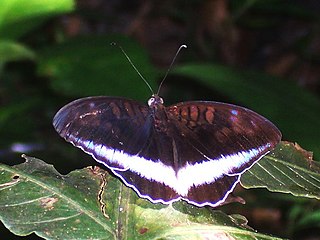
The Limenitidinae are a subfamily of butterflies that includes the admirals and relatives. The common names of many species and genera reference military ranks or – namely the Adoliadini – titles of nobility, in reference to these butterflies' large size, bold patterns, and dashing flight. In particular, the light stripe running lengthwise across the wings of many Limenitidini has reminded earlier authors of officers' shoulder marks and epaulets.
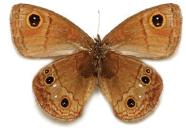
Calisto is a butterfly genus from the subfamily Satyrinae in the family Nymphalidae. Members of the genus occur on the Caribbean islands only. Of the 44 species that are currently thought to exist, 11 occur on Cuba, one on Puerto Rico, one on Anegada Island, one on Jamaica, two on the Bahamas and 28 on Hispaniola.

Danaus affinis, the Malay tiger, mangrove tiger or swamp tiger, is a butterfly found in tropical Asia. It belongs to the "crows and tigers", the danaine group of the brush-footed butterflies family.

Archaeoprepona demophon, the one-spotted prepona, banded king shoemaker, or demophon shoemaker is a butterfly belonging to the family Nymphalidae.
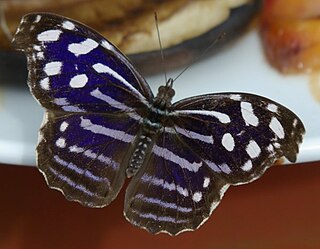
Biblidinae is the name for a subfamily of nymphalid butterflies that includes the tropical brushfoots. This subfamily was sometimes merged within the Limenitidinae, but they are now recognized as quite distinct lineages. In older literature, this subfamily is sometimes called Eurytelinae.
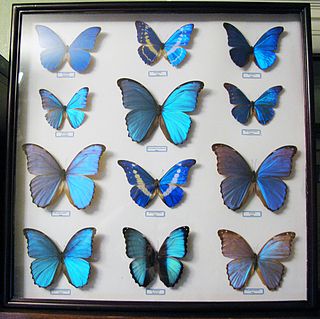
The Morphinae are a subfamily of Nymphalidae butterflies that includes the morphos, the owl butterflies (Caligo), and related lineages. It is either considered a sister group of the Satyrinae, or disassembled and included therein.
Butterfly evolution is the origin and diversification of butterflies through geologic time and over a large portion of the Earth's surface. The earliest known butterfly fossils are from the mid Eocene epoch, between 40-50 million years ago. Their development is closely linked to the evolution of flowering plants, since both adult butterflies and caterpillars feed on flowering plants. Of the 220,000 species of Lepidoptera, about 45,000 species are butterflies, which probably evolved from moths. Butterflies are found throughout the world, except in Antarctica, and are especially numerous in the tropics; they fall into eight different families.

The butterfly subtribe Euptychiina is a diverse group within the tribe Satyrini, occurring throughout Central and South America, in addition to a few species known from North America. Euptychiina is a predominantly lowland group, with the exception of one Asian taxon Palaeonympha opalina Butler, 1871 and the Andean genus Forsterinaria Gray, 1973.

Libythea labdaca, the African snout butterfly, is a member of the butterfly subfamily Libytheinae found in western and central Africa.
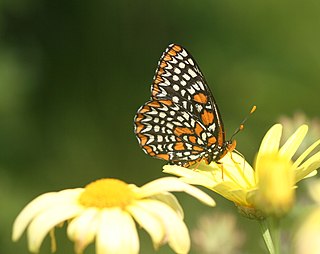
The Baltimore checkerspot is a North American butterfly of the family Nymphalidae. It has been the official state insect of the U.S. State of Maryland since 1973. The Baltimore checkerspot was named for the first Lord Baltimore due to its similarity of colors in the family crest. Despite the species status as Maryland state insect, the population in Maryland has face significant decline and is currently listed by the Maryland Department of Natural Resources as "rare, threatened, and endangered" animal list.

Junonia genoveva, the mangrove buckeye, is a butterfly of the family Nymphalidae. The species was first described by Pieter Cramer in 1780. It is found in North America from southern New Mexico, southern Arizona, southern Texas, and southern Florida south through the West Indies, Mexico and Central America to Argentina. Rare strays can be found up to southeastern California, southeastern Colorado and central Florida. In the Cayman Islands, it is known as the Caribbean buckeye.
Victor Gurney Logan Van Someren was a zoologist and entomologist.
References
- ↑ "Kumothales Overlaet, 1940" at Markku Savela's Lepidoptera and Some Other Life Forms
- ↑ Afrotropical Butterflies: Nymphalidae - Tribe Limenitidini
| This Limenitidinae article is a stub. You can help Wikipedia by expanding it. |